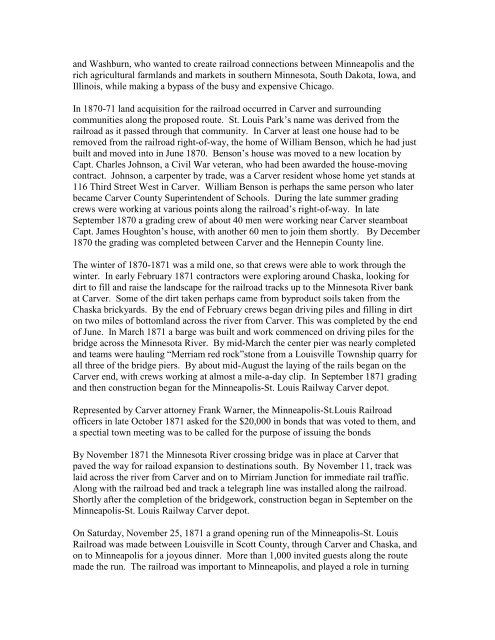Historic Homes and Businesses in Carver - Carver County Historical ...
Historic Homes and Businesses in Carver - Carver County Historical ...
Historic Homes and Businesses in Carver - Carver County Historical ...
You also want an ePaper? Increase the reach of your titles
YUMPU automatically turns print PDFs into web optimized ePapers that Google loves.
<strong>and</strong> Washburn, who wanted to create railroad connections between M<strong>in</strong>neapolis <strong>and</strong> the<br />
rich agricultural farml<strong>and</strong>s <strong>and</strong> markets <strong>in</strong> southern M<strong>in</strong>nesota, South Dakota, Iowa, <strong>and</strong><br />
Ill<strong>in</strong>ois, while mak<strong>in</strong>g a bypass of the busy <strong>and</strong> expensive Chicago.<br />
In 1870-71 l<strong>and</strong> acquisition for the railroad occurred <strong>in</strong> <strong>Carver</strong> <strong>and</strong> surround<strong>in</strong>g<br />
communities along the proposed route. St. Louis Park‟s name was derived from the<br />
railroad as it passed through that community. In <strong>Carver</strong> at least one house had to be<br />
removed from the railroad right-of-way, the home of William Benson, which he had just<br />
built <strong>and</strong> moved <strong>in</strong>to <strong>in</strong> June 1870. Benson‟s house was moved to a new location by<br />
Capt. Charles Johnson, a Civil War veteran, who had been awarded the house-mov<strong>in</strong>g<br />
contract. Johnson, a carpenter by trade, was a <strong>Carver</strong> resident whose home yet st<strong>and</strong>s at<br />
116 Third Street West <strong>in</strong> <strong>Carver</strong>. William Benson is perhaps the same person who later<br />
became <strong>Carver</strong> <strong>County</strong> Super<strong>in</strong>tendent of Schools. Dur<strong>in</strong>g the late summer grad<strong>in</strong>g<br />
crews were work<strong>in</strong>g at various po<strong>in</strong>ts along the railroad‟s right-of-way. In late<br />
September 1870 a grad<strong>in</strong>g crew of about 40 men were work<strong>in</strong>g near <strong>Carver</strong> steamboat<br />
Capt. James Houghton‟s house, with another 60 men to jo<strong>in</strong> them shortly. By December<br />
1870 the grad<strong>in</strong>g was completed between <strong>Carver</strong> <strong>and</strong> the Hennep<strong>in</strong> <strong>County</strong> l<strong>in</strong>e.<br />
The w<strong>in</strong>ter of 1870-1871 was a mild one, so that crews were able to work through the<br />
w<strong>in</strong>ter. In early February 1871 contractors were explor<strong>in</strong>g around Chaska, look<strong>in</strong>g for<br />
dirt to fill <strong>and</strong> raise the l<strong>and</strong>scape for the railroad tracks up to the M<strong>in</strong>nesota River bank<br />
at <strong>Carver</strong>. Some of the dirt taken perhaps came from byproduct soils taken from the<br />
Chaska brickyards. By the end of February crews began driv<strong>in</strong>g piles <strong>and</strong> fill<strong>in</strong>g <strong>in</strong> dirt<br />
on two miles of bottoml<strong>and</strong> across the river from <strong>Carver</strong>. This was completed by the end<br />
of June. In March 1871 a barge was built <strong>and</strong> work commenced on driv<strong>in</strong>g piles for the<br />
bridge across the M<strong>in</strong>nesota River. By mid-March the center pier was nearly completed<br />
<strong>and</strong> teams were haul<strong>in</strong>g “Merriam red rock”stone from a Louisville Township quarry for<br />
all three of the bridge piers. By about mid-August the lay<strong>in</strong>g of the rails began on the<br />
<strong>Carver</strong> end, with crews work<strong>in</strong>g at almost a mile-a-day clip. In September 1871 grad<strong>in</strong>g<br />
<strong>and</strong> then construction began for the M<strong>in</strong>neapolis-St. Louis Railway <strong>Carver</strong> depot.<br />
Represented by <strong>Carver</strong> attorney Frank Warner, the M<strong>in</strong>neapolis-St.Louis Railroad<br />
officers <strong>in</strong> late October 1871 asked for the $20,000 <strong>in</strong> bonds that was voted to them, <strong>and</strong><br />
a spectial town meet<strong>in</strong>g was to be called for the purpose of issu<strong>in</strong>g the bonds<br />
By November 1871 the M<strong>in</strong>nesota River cross<strong>in</strong>g bridge was <strong>in</strong> place at <strong>Carver</strong> that<br />
paved the way for raiload expansion to dest<strong>in</strong>ations south. By November 11, track was<br />
laid across the river from <strong>Carver</strong> <strong>and</strong> on to Mirriam Junction for immediate rail traffic.<br />
Along with the railroad bed <strong>and</strong> track a telegraph l<strong>in</strong>e was <strong>in</strong>stalled along the railroad.<br />
Shortly after the completion of the bridgework, construction began <strong>in</strong> September on the<br />
M<strong>in</strong>neapolis-St. Louis Railway <strong>Carver</strong> depot.<br />
On Saturday, November 25, 1871 a gr<strong>and</strong> open<strong>in</strong>g run of the M<strong>in</strong>neapolis-St. Louis<br />
Railroad was made between Louisville <strong>in</strong> Scott <strong>County</strong>, through <strong>Carver</strong> <strong>and</strong> Chaska, <strong>and</strong><br />
on to M<strong>in</strong>neapolis for a joyous d<strong>in</strong>ner. More than 1,000 <strong>in</strong>vited guests along the route<br />
made the run. The railroad was important to M<strong>in</strong>neapolis, <strong>and</strong> played a role <strong>in</strong> turn<strong>in</strong>g


